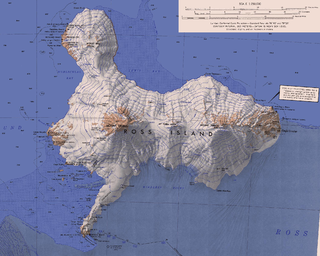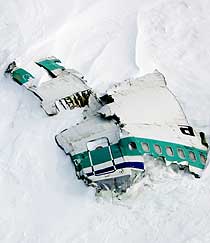In Greek mythology and Roman mythology, Erebus, or Erebos, is the personification of darkness and one of the primordial deities. Hesiod's Theogony identifies him as one of the first five beings in existence, born of Chaos.

Ross Island is an island formed by four volcanoes in the Ross Sea near the continent of Antarctica, off the coast of Victoria Land in McMurdo Sound. Ross Island lies within the boundaries of Ross Dependency, an area of Antarctica claimed by New Zealand.

Mount Erebus is the second-highest volcano in Antarctica, the highest active volcano in Antarctica, and the southernmost active volcano on Earth. It is the sixth-highest ultra mountain on the continent. With a summit elevation of 3,794 metres (12,448 ft), it is located in the Ross Dependency on Ross Island, which is also home to three inactive volcanoes: Mount Terror, Mount Bird, and Mount Terra Nova.

HMS Erebus was a Hecla-class bomb vessel constructed by the Royal Navy in Pembroke dockyard, Wales, in 1826. The vessel was the second in the Royal Navy named after Erebus, the personification of darkness in Greek mythology.

The Mount Erebus disaster occurred on 28 November 1979 when Air New Zealand Flight 901 (TE-901) flew into Mount Erebus on Ross Island, Antarctica, killing all 237 passengers and 20 crew on board. Air New Zealand had been operating scheduled Antarctic sightseeing flights since 1977. This flight was supposed to leave Auckland Airport in the morning and spend a few hours flying over the Antarctic continent, before returning to Auckland in the evening via Christchurch.

The Erebus class of warships was a class of 20th century Royal Navy monitors armed with a main battery of two 15-inch /42 Mk 1 guns in a single turret. It consisted of two vessels, Erebus and Terror, named after the two ships lost in the Franklin Expedition. Both were launched in 1916 and saw active service in World War I off the Belgian coast. After being placed in reserve between the wars, they served in World War II, with Terror being lost in 1941 and Erebus surviving to be scrapped in 1946.

HMS Terror was a specialised warship and a newly developed bomb vessel constructed for the Royal Navy in 1813. She participated in several battles of the War of 1812, including the Battle of Baltimore with the bombardment of Fort McHenry. She was converted into a polar exploration ship two decades later, and participated in George Back's Arctic expedition of 1836–1837, the successful Ross expedition to the Antarctic of 1839 to 1843, and Sir John Franklin's ill-fated attempt to force the Northwest Passage in 1845, during which she was lost with all hands along with HMS Erebus.

Miran Vodovnik is a Slovenian shot putter. His personal best throw and Slovene record is 20.76 metres, achieved in June 2006 in Thessaloniki.

The Erebus Ice Tongue is a mountain outlet glacier and the seaward extension of Erebus Glacier from Ross Island. It projects 11 kilometres (6.8 mi) into McMurdo Sound from the Ross Island coastline near Cape Evans, Antarctica. The glacier tongue varies in thickness from 50 metres (160 ft) at the snout to 300 metres (980 ft) at the point where it is grounded on the shoreline. Explorers from Robert F. Scott's Discovery Expedition (1901–1904) named and charted the ice tongue.

Miran is an ancient oasis town located on the southern rim of the Taklamakan Desert in Xinjiang, Northwest China. Located where the Lop Nur desert meets the Altun Shan mountains, Miran was once a stop on the famous trade route known as the Silk Road. Two thousand years ago a river flowed down from the mountain and Miran had a sophisticated irrigation system. Now the area is a sparsely inhabited, dusty region with poor roads and minimal transportation. Archaeological excavations since the early 20th century have uncovered an extensive Buddhist monastic site that existed between the 2nd to 5th centuries AD, as well as the Miran fort, a Tibetan settlement during the 8th and 9th centuries AD.
Mirannes is a commune in the Gers department in southwestern France.

Erebus is a genus of moths in the family Erebidae.

Erebus Montes is a group of mountains in the Diacria quadrangle of Mars, located at 35.66° North and 185.02° West. It is 811 km across and was named after an albedo feature at 26N, 182W.

Erebus crepuscularis is a moth of the family Erebidae first described by Carl Linnaeus in his 1758 10th edition of Systema Naturae. It is found in Indonesia, New Guinea, Taiwan and the Australian states of Queensland and New South Wales.
Erebus Glacier is a glacier draining the lower southern slopes of Mount Erebus, Ross Island, Antarctica. It flows west to Erebus Bay where it forms the floating Erebus Glacier Tongue. It was named in association with Mount Erebus by the British National Antarctic Expedition, 1901–04, under Robert Falcon Scott.

Mount Terra Nova is a snow-covered inactive volcanic mountain, 2,130 m (6,990 ft), between Mount Erebus and Mount Terror on Ross Island. It was first mapped by the Discovery expedition in 1901–04, and named for Terra Nova, the relief ship for this expedition and the British Antarctic Expedition, 1910–13.

Miran Jarc was a Slovene writer, poet, playwright and essayist.

Miran Pastourma is a renowned pastourma and sujuk charcuterie business and market in Athens, Greece. The market has been in operation since 1922. It is considered the charcuterie of the connoisseurs. Despite the Greek economic crisis, Miran is expanding its business and has doubled in size to accommodate increased demand. The founder of the shop, Miran Kourounlian, is thought to be the man who brought pastourma to Athens for the first time. Miran is considered the largest company of its kind in the European Union. The flavour of pastourma coming from the historical enterprise permeates Euripides Street in the centre of Athens. Miran and its neighbor Arapian Cold Cuts are considered two of the historical establishments of Athens. Miran has been in the same spot in Euripidou Street since its opening in 1922. Miran is the recipient of multiple gourmet prizes.

Hercai is a Turkish romantic television series starring Akın Akınözü and Ebru Şahin, along with Gülçin Santırcıoğlu, Serhat Tutumluer, Oya Unustası and Ahmet Tansu Taşanlar. It premiered on ATV on March 15, 2019. ATV has sold rights to air the series in various international markets, including most of Latin America and the United States through Telemundo, which premiered on June 22, 2021.














